2007 Sea Doo Gtx Limited Supercharged
Sea Doo Model Reference (1988-2010)
This page hopefully describes in detail from beginning to now all Sea Doo models, their benefits, features, and any positive and negative about each model. Note also that occasionally below I've interjected my opinions about models and/or the direction the industry is headed and they're just that... only my opinions. Since I'm putting this together from memory there may be some errors so if you see one (or more), please point them out! If you have anything to contribute to the page, please feel free to e-mail me!
At some point I also plan to have a chart that shows all specs including hull design and more for all years and if I do, a link will be posted on this page. In the mean time, my Fuel Economy Chart has specs and info for many models.
Although the first Sea Doo watercraft really appeared in 1968, for our purposes, we'll be starting with 1988 since that's the first year for the "modern" Sea Doo PWC. Also, if you hold your mouse over an image without clicking, it should display the year and model to help with identifying the pictures.
A brief rundown of the modern history of the Sea Doo model line...
1988
Although I don't recall ever seeing one, Sea Doo first "arrived" in 1988 with a unique hull design and seat that opened different than the 1989 and up. It was equipped with the 587 Yellow motor which was in all Sea Doos from 1988 to 1991. The SP is technically a 2 passenger machine although that hull was pretty tippy with anything more than a couple kids onboard. I would guess not many were sold since they're pretty scarce compared to the 1989 SP. The person below sent me the pictures and info on his really nice 1988 so I added it below. If anyone else has one of these, info on it, or pictures of them, I would love to add it to this page too!.
"You stated that you had not seen and did not have a picture of a 1988 first year Model 5801. I was a July 1988 purchaser of the first year model and still have it. It has not been stored and has been used every summer since 1988. It is original (except for batteries and impeller) and the engine is completely original (rings, pistons, etc.). I have used BRP two stroke oil exclusively and the heads of the pistons are clean and carbon free. The 1988 had a rear hinged seat with piston support that opened clam shell style rather than coming off like the 1989. I have attached photos taken last year of the 1988 and the engine. It is literally showroom." - YOU WEREN'T KIDDING! SEE THE PICTURES BELOW.
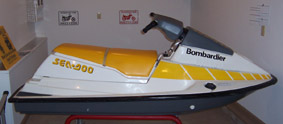
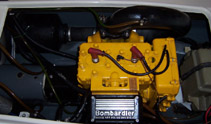
12/2017 - I now have a 1988 in pretty good condition too and will be posting pics soon.
1989
The 1989 SP had a new engine access design which Sea Doo will stick with on all future models. It features a removable seat that comes off to access the engine and electrical. Sea Doo will stick with this "squared off" hull design on the SP through 1993.
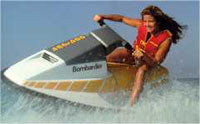
1990
In 1990 Sea Doo kept the SP in the lineup and also introduced the first 3 passenger GT model which featured a basically smooth hull which was fun for spins, but also could get pretty unstable with three. Since it had the 587 (twin carb), it also wasn't the most powerful or fast but the old 587 was pretty indestructible. The GT also was the first time Sea Doo introduced the reverse feature on a ski.
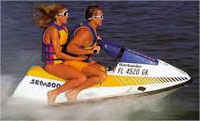
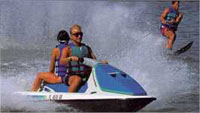
1991
In 1991, the SP and GT (basically the same machines as 1990) were in the lineup, plus the XP makes it's first appearance. The XP was basically the SP hull with the Twin Carb 587 installed. The XP hull did feature a hood with mirrors for the first time. Sea Doo also finally added a grab handle to the SP which really helped with reboarding!
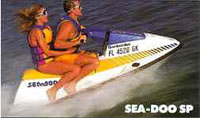
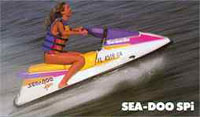
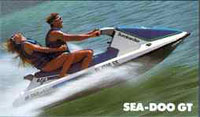
1992
In 1992, the white 587 engine makes its' first appearance and the yellow one is history. All models in 1992 are equipped with the 587. The SP and XP basically were the same as 1991, but the XP now shows the first appearance of trim, although manual for this year.
The GT now changed its' name to the GTS but also remains pretty much the same as the 1991 with the exception of a white lower hull with strakes instead of the grey smooth GT style.
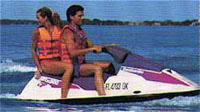
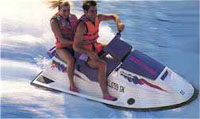
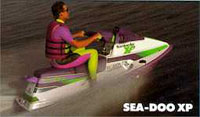
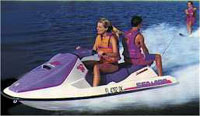
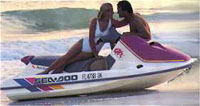
1993
In 1993, we see the first larger cc engine with the 657 in the XP. The XP also features a new design hull and rounded more modern body pieces as well. A pump with more durable bronze vanes also was used on the XP. The 1993 XP is the first to have electric trim available as well. In 1993 the SPX (587 dual carb), which was basically the 1992 XP, is in the lineup. Sea Doo continued to do that with the SPX for most of the �90s as well. The SP (587 single carb) was offered as well as the SPI (587 single carb) which had a stainless impeller and a different pipe.
The GTS 3 seat was in the lineup and the first GTX 3 seater made it's appearance. The GTX wasn't much different than the GTS although it did have a fuel gauge and a couple other options not found on the GTS. The GTX also had a little more power due to dual Mikuni carbs.
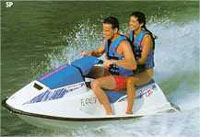
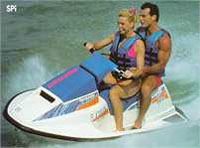
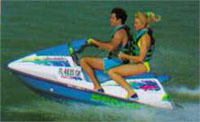
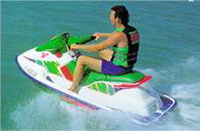
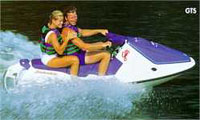
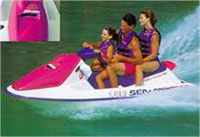
1994
In 1994 we really start seeing Sea Doo update the design on the new models. The SP (587 single carb) and SPI (587 single carb) are again offered and were popular in the rental field. They also offered the SPX (657 dual carb), which was basically the 1993 XP. The XP for 1994 featured the 657X engine that had more hp than the standard dual carb 657. As far as features go though, the 1994 XP was pretty much the same as the 1993. They also offered an XPI (657 dual carb) but I can't remember what differentiated it from the XP.
The GTS was pretty much the same ski as the 1993 GTS, but the GTX now features the 657 engine and bronze vane pump, as well as a full compliment of gauges and even mirrors so you can pull a skier.






1995
In 1995 we get our first glimpse of two new larger engines when the 717 and 787 make their first appearance. The SP (587 single carb) and SPI (587 single carb) are in the lineup once again. The SPX (657X engine) is once again basically the 1994 XP with different colors.
The GTS is basically the same ski as the 1994, but the GTX gets the 657X engine as well as sleeker looking mirrors. An optional Touring Seat (hard to come by these days) offered on the GTX (it's shown on the GTX picture below) made the GTS and GTX really ride well, although it was molded to seat two instead of the flat seat that could accommodate three. That seat will fit all the 1990-2001 GT style hulls and could be found in purple/green, purple, and yellow.
The XP now gets the new 717 engine, which was the largest rotary valve motor released in a Sea Doo. It also features a different design trim system and a pump extension to increase the water volume in front of the pump. The XP800 also is released in limited numbers and it features the 787X RAVE valve engine. Now we're talking some power!
The final new release for 1995 is the HX, which really is basically a motorcycle for the water. I believe Sea Doo released it to compete in the same racing class as the Yamaha WaveBlaster and it had similar riding characteristics as well as a 717 engine for power. It's a long narrow ski that takes some getting used to but is lots of fun once you get the hang of it. What it featured that made it really unique though was the first appearance of a seat with a suspension.








1996
In 1996, the 657 engine is totally phased out and won't be seen again in a PWC. This year, we also see Sea Doo switching to the DESS ignition system which lots of people have varying opinions on. It allowed for better monitoring of the Sea Doo engine functions as well as security, but also makes the MPEM dramatically rise in replacement price. Now you need to take it to the dealer if you lose your lanyard as well.
The SP (587 single carb) and SPI (587 single carb) are in the lineup yet again. The SPX (717 dual carb) is once again basically the 1995 XP with different colors. The XP now features the 787 RAVE engine and is probably the most desirable of the X4 hull design models built. The HX (717) stays in the lineup as well and stays basically unchanged besides graphics.
We still have the GTS (587 single carb) in the lineup, but we get the new GTI which is the same hull design as the 1995 GTX but with a 717. The GTX is the first really new 3 passenger hull design since 1990 and features larger front storage, a two piece removable seat, and the 787 for adequate power for about anything you want to do.
This year we also get a new model 2 seater in the GSX. It's powered by the 787 and is slightly slower than the XP but more stable with two. The GSX and the GTX are the first now to also incorporate a digital infocenter that gives you lots of information instead of just a couple functions of the old 2 ones.
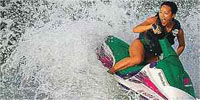
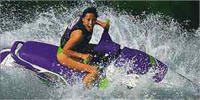

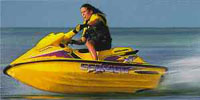
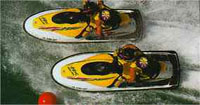




1997
In 1997 the original 587 engine that started it all is totally phased out and won't be seen again in a PWC. New this year though is the release of the 130hp Rotax 2 cylinder 947 RAVE engine, the largest of all the two stroke Sea Doo engines and the most horsepower per cc of any PWC engine out there!
The SP (717 single carb) is still in the lineup but its' days are numbered. The SPX (787 dual carb) is once again basically the 1996 787 XP with different colors. The XP is a new hull design with the 787 RAVE motor located in the front and a suspension seat like the HX. Quite a different ride than the X4 hulls! The HX (717) stays in the lineup as well for 1997.
This year, the GSX (dual carb 787) also gets a couple more models in that hull platform with the GS (717 single carb) and the GSI (717 single carb). The GS is the base model with pretty much no features with only a fuel gauge and no trim while the GSI and GSX have the digital infocenter and electric trim. The late production GSX Limited features the new 947 white engine with 130hp. Since this is the first time we see those, they also have quite a few bugs that get worked out in the later silver engines.
The 717 GTS is the base model 3 seater still featuring the old style hull and is basically the same ski as 1996 GTI with no infocenter. The GTI for this year gets the new style hull like the 1996 GTX but has the smaller 717 engine and no infocenter, just gauges. The GTX for 1997 is almost exactly the same ski as the 1996 even down to the colors.
It's worth mentioning this year marks the beginning of the use of the new style ignition module. Instead of components being in a waterproof grey box, most everything plugs into and goes through the MPEM mounted on a plate usually in the front of the ski. Although the design works well, from now on it's going to cost quite a bit more for a new MPEM. The only exception is the SPX and GTS, which will continue to use the old style.
On a final note, late in 1997 the GSX Limited with the 130hp 947 RAVE engine also is released but it's actually considered a 1998 model.

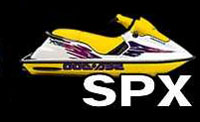

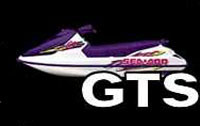
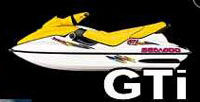




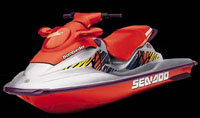
1998
In 1998 we lose some models, but in exchange get the new 787 RFI Fuel Injected RAVE engine. Due to new stricter environmental rules, the push from now on will be towards more fuel efficient, less polluting PWCs.
The SP (single carb 717) is in the lineup for the last year. This year the SPX is basically the 1997 SPX but loses a little weight somewhere, making it the lightest one of all the X4 hulled 787 SPX models so probably the most desirable one. The XP keeps the same hull design as the 1997 but also now adds Limited to the name and comes with the 947 (dual carb).
The GS (717), GTS (717) and GTI (717) basically don't change anything besides colors from 1997.
The GTX comes for the first time with a 787 RFI engine which offers the same power as the 787 carb model, but improved fuel economy and better emissions. The GTX as well as the GSX now have Limited added to their names and come with the new 130hp 947 carbureted engine and that really gives them some life. The white 947 engine is gone and replaced with a better design silver one as well.
Since late 1997 is the first year for the 947 engine, on the first models they do have some problems with water ingestion as well as some pump issues, but most should have been repaired and updated under warranty.












1999
In 1999, not much new comes out probably due to Sea Doo putting all its' efforts into the upcoming 2000 models.
The SPX (787) is basically the same X4 hull as the 1997-1998 SPX, but for some reason slightly heavier than the 1998. This will be the last year you'll see that hull design offered.
The GS (717), GTS (717) and GTI (717) basically don't change anything besides colors from 1998.
The GTX RFI (787) is in the lineup again as well as a new GSX RFI (787) model. The 947 powered GSX Limited, GTX Limited, and XP Limited are basically the same skis as 1998 although they had most of the bugs worked out now.









2000
In 2000 we get a whole bunch of new models, a new DI engine and some bold graphics to let you know they're a 2000 model. As said previously, my guess the lack of new models in 1999 was so they could hit us with all these cool skis for the new millennium!
The 717 GS, 717 GTS and 717 GTI basically don't change anything besides colors from 1999. The GTX RFI (787) as well as the GSX RFI (787) model are in the lineup and pretty much unchanged from 1999. Sea Doo drops the Limited designation on the 947 skis this year too. This year, we also have the GTX and XP that are basically the same as 1999.
Now for the new. This year Sea Doo comes out with the 947 DI engine which offers the same power as the 947 carb model, but improved fuel economy and better emissions. That engine goes in a GTX DI and a new model, the RX DI. There is also a base RX with a 947 carb engine and the new but short lived LRV (dual carb 947). The LRV has to be the largest PWC ever made seating 4 and taking up lots of space in the garage!










2001
In 2001, this is the last year we see the 717 GTS that used the old style hull (1990-2001) (possibly actually phased out in 2000).
We get a new GTS though and it's basically the same as the GTI, but with less bells and whistles. It may use a different hull than the GTI as well but not sure on that one. We also see the 717 GTI in the lineup again.
The GSX RFI, GTX RFI, GTX DI, RX DI, GTX, RX, XP and LRV all basically are the same machines as the 2000.
There is one big change for 2001 though in the form of two color options for almost every model. We do also see a limited production race machine designated RXX which I've read is the fastest stock production 2 stroke ever made.
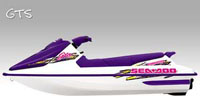

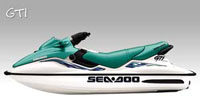

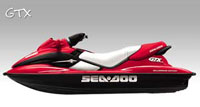

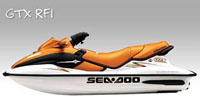

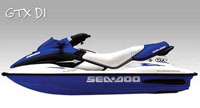
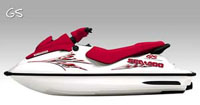
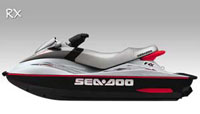

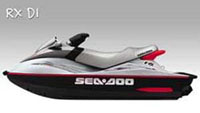


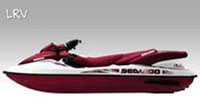

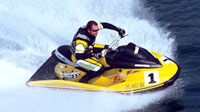
2002
In 2002, we see the first of what will become the base of all Sea Doo power to come. I'm referring to the 1503 4-TEC 3 Cylinder 4 Stroke engine. We also see the OPAS (Off Power Assisted Steering) first this year as well on the GTI LE (717) and the GTX 4-TEC. This year, we still have many of the same 2 strokes including the GTI, GTX, GTX RFI, GTX DI, RX DI, RX, and XP. The GTI LE is basically the GTI but with a different hull featuring OPAS. The 2002 GTI LE, GTX DI and GTX 4-TEC also now use a different design upper hull utilizing a new style hood and different seat design than 2002. New this year also is the LRV DI.










2003
In 2003, we see the first Supercharged 4-TEC in the GTX model. We still have the GTI (717) and the more optioned GTI LE (717) as well as the new GTI LE RFI (787 RFI). We also still have the standard 155hp GTX 4-TEC, GTX DI, RX DI and XP DI and LRV DI. This is the last year though for the LRV due to poor sales I would imagine. This is also the last year for the RX model.










2004
In 2004, we start to see the direction Sea Doo and most of the PWC industry is headed with more 4 strokes and less 2 strokes in the lineup. This is the first year for the new Supercharged RXP, which I would guess was meant to be the replacement for the 130hp RX model. What a replacement!
This year we still have the GTI (717), GTI LE (717), and GTI LE RFI (787 RFI) models as well as a new GTI RFI (787 RFI) model. The GTX 4-TEC and Supercharged models are still in the lineup as well. It's worth mentioning that the majority of the 2004 models haven't changed and even have the same color scheme as 2003 which I would guess was probably since Sea Doo put most of their resources into developing the RXP.
Although the XP DI is in the lineup again, this will be the last year for the XP model line. Also, as mentioned this is the first year for the RXP and it turns out to be arguably the most popular Sea Doo in years.
Maintenance note... the new supercharged 4TEC models are having lots of problems with the drive. The ceramic clutch discs are great at dissipating heat but they break easy. The pieces get into the oil system and it's quite a job and expense to clean them out. If an owner of one of these skis notices it slipping, they need to get it in for service BEFORE it breaks!









2005
In 2005, we still have the GTI (717), GTI LE (787 RFI), and GTI LE RFI (787 RFI) models as well as the GTX 4-TEC and Supercharged models. A new model to appear is the GTX (4-TEC) Wake model which is set up for wakeboarding and similar activities.
The new 4 stroke model for this year is the RXT Supercharged model. It's basically the two passenger model of the RXP and is a little longer and slower than the RXP. As for the RXP, it's basically unchanged from 1994 besides different trim. Both the RXP and RXT come in either Red or Green color schemes this year.
Finally, I would guess since they pulled the XP in 1994, Sea Doo also released a new single seat 2 stroke model called the 3D, equipped with the 787 RFI engine. The ski is kinda like the transformers toys you might have had as a kid. It changes from stand up to sit down and all together there ends up being 5 different riding combinations you can use on the ski. Although it isn't a very popular ski, I have heard it's a whole lot of fun to ride!









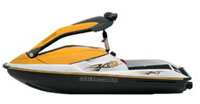
2006
In 2006, you really start to see the way Sea Doo is headed with the emphasis on 4 stroke models. All 2 strokes have been eliminated with the exception of the 3D, which now has the more powerful 947 DI installed.
The GTI models are all 4 stroke powered now and the GTX models from last year are also are in the lineup. The RXT and RXP also of course are back as well.
By now, the only real mechanical fault worth mentioning is well known among those who own the Supercharged models. The infamous clutch problems! Sea Doo addresses it with a heavier duty clutch package and aftermarket sources also have good solutions available.
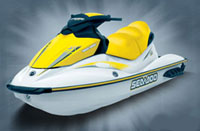
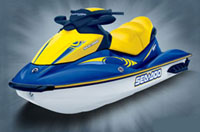
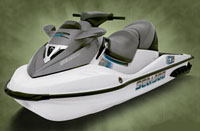
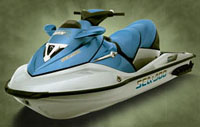
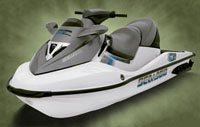
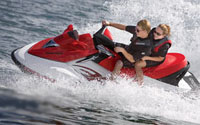
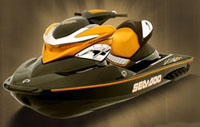
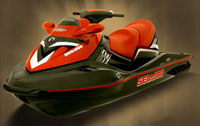
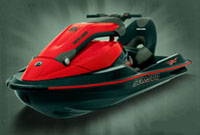
2007
In 2007, all models from 2006 are offered but in different colors than last year. The only real new addition is a 155hp RXP which has been a big debating point on the many Sea Doo forums. It's a bit like putting a V6 in a Corvette, but those who are less experienced riders would most likely benefit from the less powerful model. The RXP (maybe RXT too) does have a change to the steering column making it more vertical and people say that's an improvement. This is the last year for the poor selling 3D DI too although from what I've read, anyone who has actually owned or rode one loves them! A salute and RIP to the two strokes that started it all!
Maintenance note... There's still problems with the supercharger drive but new metal washers make them last much longer. Still, if you notice a lack of rpms, get your ski in for service BEFORE it breaks!
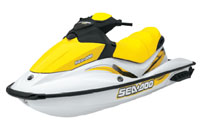
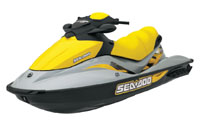
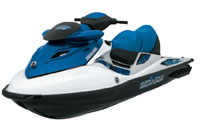
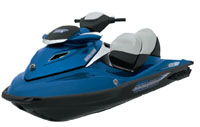
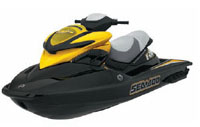

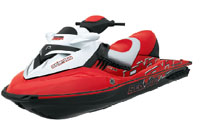

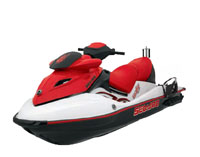
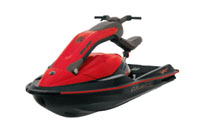
2008
In 2008 BRP hits us again with two new models... the RXP-X and the RXT-X. These have an incredible 255hp and are the most powerful PWCs ever. I believe Sea Doo picked the 255hp option to combat Yamahas 250hp ski and these new models blow any other ski away for acceleration, handling and features. From 0 to 50mph in 2.9 seconds, you almost need a seat belt!
With all these great features though people lose the fact that these now are so complicated and expensive that we've totally gotten away from what a PWC originally was. These are basically boats that have to go to a dealer for even the simplest maintenance needs.
A note about the ever increasing HP figures... Although Sea Doo and other PWC manufacturers have always had a constant battle to put out a ski that one-ups the competition, you'll notice that any new ski (no matter who makes it) will ever go past 70 mph. The reason for that is the PWC manufacturers have an agreement with the USCG (and maybe insurance companies too) to keep the speeds in check. The way Sea Doo does it is to limit the hull design. They put out huge hp but then the add weight and design the hull so it's really hard to get over 80mph safely. Yamaha has a great lightweight hull but limit speeds with the drive train design. What's really interesting about that is now people are putting the RXP engine in the Yamaha hull and have built the first PWCs that will break the 100mph barrier. You couldn't pay me to ride on a PWC going that fast though!
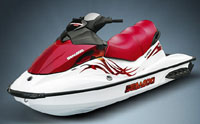
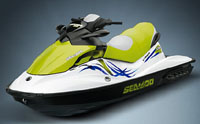
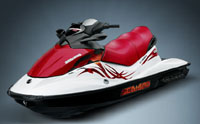
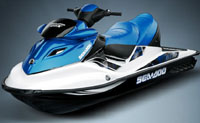
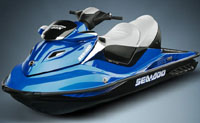
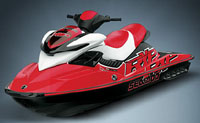
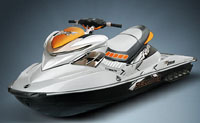
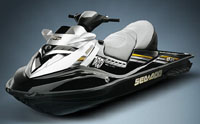
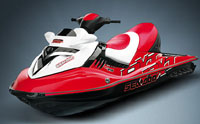
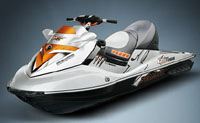
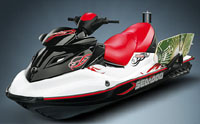
2009
In 2009 there isn't much change in the lineup or performance with the exception of the new iS concept. The iS stands for "Intelligent Suspension" and from what I hear, it offers an incredible ride. Although the new GTX Ltd iS is a really incredible state of the art craft with intelligent suspension, intelligent throttle, and even brakes, it seems to me that Sea Doo is trying to make an idiot proof ski anyone can ride. I've found though it's much better to keep the idiots off the water than giving someone with no common sense or skill a product that's easier to operate. From what I see too, this outrageously expensive ski looks like a nightmare to repair if it breaks so make sure you get an extended warranty if you're planning on buying this $16,500 machine!
A comment on the supercharger issues... Sea Doo now installs metal supercharger washers in all the Sea Doo models that are supercharged. They still can fail though so therefore Sea Doo calls for the supercharger to be rebuilt every 100 hours. Many dealers won't tell a person that when buying a ski so keep that in mind if you own one or are considering purchasing a supercharged model. I've been hoping for a better design with less maintenance but I now believe that's not going to happen.
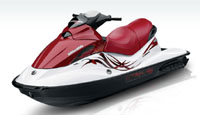
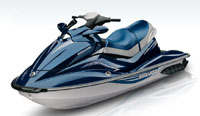
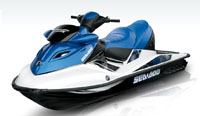
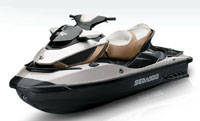
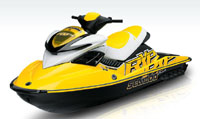
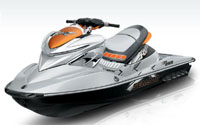
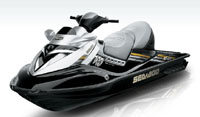
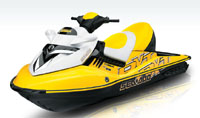
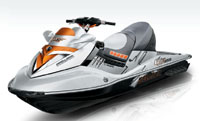
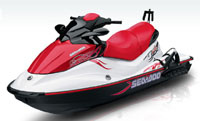
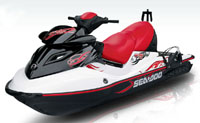
2010
In 2010, the lineup is pretty much the same as last year but with the addition of the RXT iS 260. The GTX iS also is now also 260hp. Not sure where the extra 5hp was found but it's once again probably a bragging thing. Not sure why they didn't give the RXP-X the 260hp badge but maybe they're saving that for 2011.
You would think I would be impressed with all these new models and new features but I'm not. As I've stated before, I don't like complicated expensive skis that few can afford. The ski I probably like best in the 2010 lineup is the lowly GTI that's the least expensive Sea Doo you can buy at $7,999. The reason though I like the GTI is mainly the color. I've never seen anyone release an almost all white PWC and that's pretty cool. This one should be popular with people who own large yachts since they generally like a ski that blends in with their yacht and looks like it belongs there. While on the subject of color, anyone who has been in the tropical sun knows that dark colors on a boat aren't the smartest idea since they get really hot. Therefore I can't imaging how you can walk up and hop on a new RXP-X or RXT-X once it's been setting out in the sun in South Florida for any length of time!
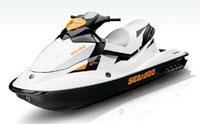
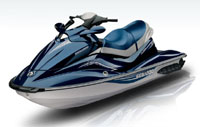
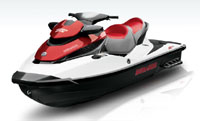
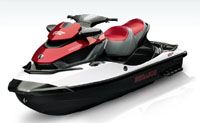
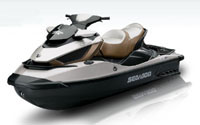
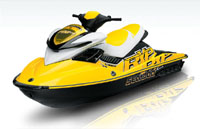
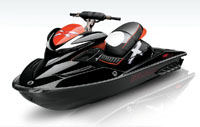
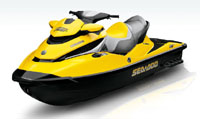
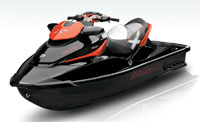
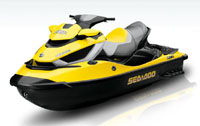
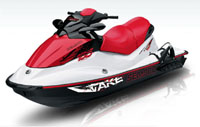
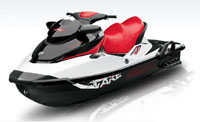
What's up with these prices?!! The GTI and the GTI SE are now the only skis left that are below $10,000. Aren't manufacturers paying attention to the economy? We can't afford these crazy prices these days! Gone are the days of a $5000 ski and even used 4 stroke ski is priced crazy. The cost of a PWC these days now seems to be getting way out of the reach of pretty much anyone except those with exceptional credit. As many people have found out too, the banks aren't giving out that stimulus money they got from us. The only good thing about these high priced new models is they're fueling the resurgence and resurrection of the 'ol 2 stroke smokers and I like that!
As I said at the beginning, since I'm putting this together from memory there may be some errors so if you see one (or more), please let me know! If you have anything to contribute to the page, please feel free to e-mail me!
2007 Sea Doo Gtx Limited Supercharged
Source: https://www.seadoosource.com/seadoomodelreference.html


Tidak ada komentar: